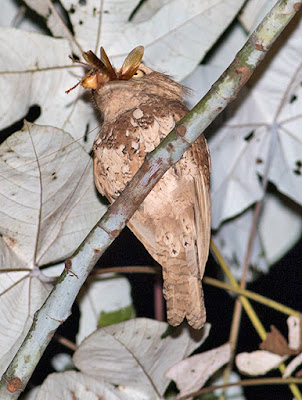Four our
second full day at the wonderful Borneo Rainforest Lodge in Danum Valley, we
changed tack. Rather than walking out from the lodge and into the forest, (as we'd done before), we
drove out and birded the road and trails further afield. Our main aim for our
starting port of call was to see the endemic White-fronted (Bornean) Falconet,
which was said to be coming to prey on insects that were attracted to a small
building that left its lights on overnight. On arrival at the building the
insect harvest was not too impressive, and so may have explained the reason for
a complete lack of falconet. We did however, pick up a pair of Diard’s Trogon as some form of avian compensation. Moving
back towards the forest trails again our eagle-eyed local guide spotted a tiny
bird sitting on a distant dead snag, which turned out to be the world’s smallest raptor, none other than a
White-fronted Falconet! However, our local guide, Azmil, was not done just yet;
as we peered gratefully at the falconet, he gestured up front, where our first
Bornean Orangutan was foraging languidly in a tree ahead of us. Late in the
morning, there was palpable relief when we finally connected with a
cerulean-capped male Blue-headed Pitta, one of the most stunning endemic
species on the island of Borneo, (that is home to more than 50 birds found
nowhere else).
The
remainder of the day was often like pulling teeth, with long periods of
inactivity, with target birds calling at us, but remaining hidden (including the now
daily taunt from one of the local Bornean Banded Pittas!), and studded with a smattering of new
birds, like Long-billed (Large-billed) Blue Flycatcher and Rufous-backed
Dwarf-Kingfisher, and another Bornean Blue Flycatcher. It was becoming
traditional to see something spectacular over lunch from the lodge, (after
yesterday’s Black-and-yellow Broadbill, and
the day before’s Yellow-rumped Flowerpecker), and
this day was no different, with a pair of Rhinoceros Hornbills interrupting the
well-stocked buffet. In the evening, the group made different choices, some like
Gary and Gail, headed out on another night drive in the hope of rare mammals,
while Chris and I went in search of nightbirds closer to the lodge. We were
hoping to add to the confusingly low number of sightings of Oriental Bay Owl on
the lodge property, but heard not a peep from that locally rare species.
However, we did find the regular Brown Wood-Owl hanging out near the staff
quarters, which was new for the trip. As we left the owl behind some red eye
shine revealed an absurdly confiding Leopard Cat, hanging around the same area
too. I was determined to find some more nightbirds, which are only recently
becoming better known at this site; however, Chris was done and headed back for
bourbon and bed.
My personal goal was to track down an Oriental
Bay Owl or a Gould’s Frogmouth. The former was, of course, highly
unlikely, and the latter was known to be around, but I was informed “never”
came in to playback. This was like a red rag to a bull for me. I only knew a
rough area where it had been seen (i.e. the name of the trail and no more), and
so set off there, and played the call hoping for this denizen of the night to
respond. Amazingly, it only took a few tries to receive a reply. I began to
feel cocky, instantly; this was going to be easy. However, 30 minutes passed
and I felt no closer to seeing the bird, so maybe the local guide was right
after all, (they usually are). I took a break from that and went off in search of other nightbirds,
but, finding nothing, headed back. On the way back I heard, once again, the Gould’s Frogmouth taunting me all over again. I
decided to have one last try, so I found a spot with some nice, close perches that
were begging to be used by a frogmouth, and tried playing back its call again.
Suddenly, this stubborn bird, which had previously seemed unmoved by my
overtures, was calling right on top of me! I swept the near branches with the
spotlight, and there it was glaring back at me with large cheek whiskers, and
bold eyes. I was stoked, and quickly reeled off a set of photos, fearing it would
swiftly return to its earlier, considerably more lofty perch. However, it merely remained there, glued
to its branch, until I walked away. I got back to my lodge cabin after 10pm,
sweat-drenched, and ready for a shower, but quickly noticed that Gary and Gail’s cabin lights were still on. Dare I ask them if
they were interested in a sweaty 20-minute walk for a frogmouth which had likely moved
on? Of course I did, as I so wanted someone else to see this bird! I was
expecting, at this late hour, that a grumpy "NO!" would come back at me, but Gary
quickly revealed his keenness to try and Gail was quick to follow too. Once
leech socks were donned again, we returned to the spot, and to my utter shock,
the bird was still sitting quietly on the very same perch, near eye level. The
outcome: THREE nights, THREE frogmouths! (1 Blyth’s, 2 Large, and 3 Gould’s), a series I am unlikely to repeat too soon.




































